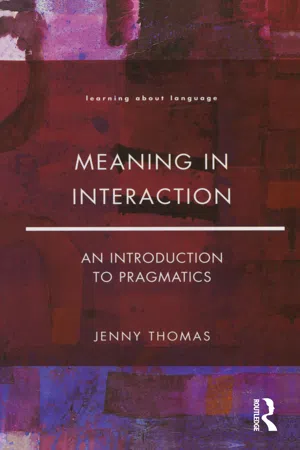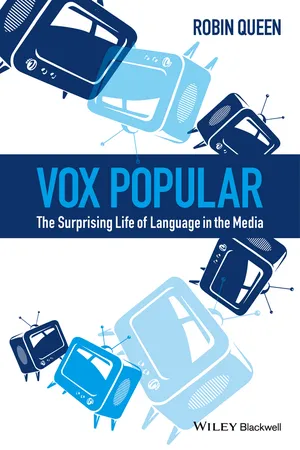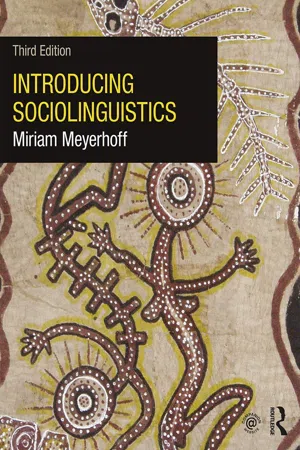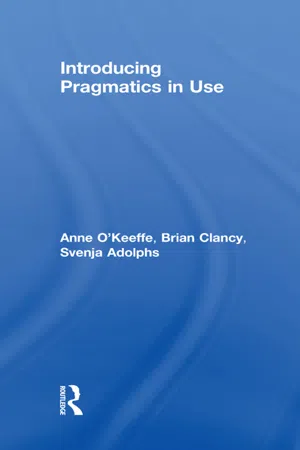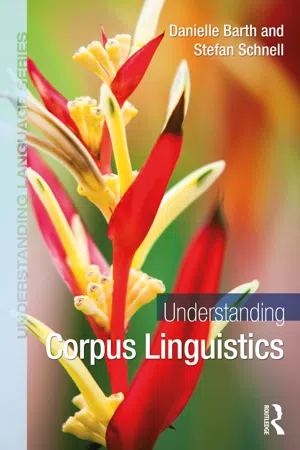Languages & Linguistics
Levels of Formality
Levels of formality refer to the different degrees of politeness and professionalism in language use. In communication, formal language is characterized by adherence to grammar rules, use of complex vocabulary, and avoidance of slang, while informal language is more relaxed and conversational. Different situations and relationships may call for varying levels of formality in language.
Written by Perlego with AI-assistance
Related key terms
6 Key excerpts on "Levels of Formality"
- eBook - ePub
Meaning in Interaction
An Introduction to Pragmatics
- Jenny A. Thomas(Author)
- 2014(Publication Date)
- Routledge(Publisher)
register refers to 'systematic variation ... in relation to social context' (Lyons 1977: 584) or the way in which 'the language we speak or write varies according to the type of situation' (Halliday 1978: 32).Certain situations (e.g. very formal meetings) or types of language use (e.g. report-writing versus writing a note to a close friend), as well as certain social relationships, require more formal language use. This 'formality' may manifest itself in English by the choice of formal lexis and forms of address, the avoidance of interruption, etc. (see note 2), while in languages such as Japanese and Korean the formality will be marked additionally by forms such as the Japanese degozaimasu discussed in section 6.2.2.As with deference, register has little to do with politeness and little connection with pragmatics, since we have no real choice about whether or not to use formal language in formal situations (unless we are prepared to risk sanctions, such as social censure). Like deference, register is primarily a sociolinguistic phenomenon: a description of the linguistic forms which generally occur in a particular situation. Choice of register has little to do with the strategic use of language and it only becomes of interest to the pragmaticist if a speaker deliberately uses unexpected forms in order to change the situation (in the same way that we may switch from a V to a T form in order to change a social relationship) or to challenge the status quo. Examples of the former might be if a prospective postgraduate student dropped into a university department for a chat and something which began as an informal, information-seeking event was changed by one of the participants into a formal admission interview. An example of the latter would be if you decided to disrupt a stuffy meeting by using language not normally associated with that particular type of event, such as cracking jokes or making fun of the person chairing the meeting. - eBook - ePub
Vox Popular
The Surprising Life of Language in the Media
- Robin Queen(Author)
- 2014(Publication Date)
- Wiley-Blackwell(Publisher)
Peter Pan highlights contextual formality at the same time as it highlights the scale of standard and non-standard language form. For instance, in line 14, the Chief makes it clear that the situation is more formal than the Lost Boys are used to in their interactions with him, something captured in line 15 when Slightly calls him ‘a spoofer.’ In response in line 16, the Chief reiterates that this time is different from previous times when the activity was a game. This example nicely illustrates the formal/informal dimension of language variation as distinct from other dimensions such as relative standardness. Even though the Chief is being very formal, he continues to speak using relatively non-standard linguistic forms. Additionally, we see juxtaposition between John and all the other characters. John uses extremely standard speech, including a recognizable BBC accent. While the situation is generally a formal one, John as a character is relatively more formal than the Lost Boys.The formality scale can be thought of in terms of the intimacy of the relationships involved. Generally, the better we know someone, the more informal we will be. Similarly, the more serious, important, or ritualized the situation is, the more formal we are likely to be. We interact differently with people we know well when we are in a formal situation, such as a business meeting, than in an informal situation, such as a game of racquetball. In the case of the Peter Pan example, the less intimate relationship between John and the other characters may help explain some of his speech while the relatively more intimate relationship between the Lost Boys and the Chief leaves the Chief having to do more work to shift the formality of the situation, since their interactions are often less formal.Food for Thought
Construct both a formal and an informal e-mail message inviting someone you know to a birthday party. What are the features involved? How do the two messages compare to each other?Language itself can play an important role in helping to define the relative formality of a situation. Formal linguistic styles typically include more standard grammar and lexical choice, including the general lack of what might be called “slang.” Formal styles may also include more Latinate than Germanic lexical items (for instance, ‘perspire’ instead of ‘sweat’ or ‘inquire’ instead of ‘ask’) and will generally include more elements linked to formal writing, such as more complex syntactic structures and a lack of contracted forms.Naming conventions provide fairly easy access to thinking about formality scales because it is often a shift in naming conventions that can signal (and hence create) changes to either the situation, the relationship between the participants, or both. We expect people who don’t know us well and people whom we consider somehow subordinate to use some sort of title when they use our names. In the United States, for instance, children often use “Mr.” and “Mrs.” to refer to adults, even when the adults are close family friends. This usage is typically asymmetric in that adults virtually always refer to children using their first names. It is highly unusual for adults in the United States to have asymmetric naming practices, something that indicates a general ideology of equality. At the same time, it is not unheard of for such asymmetric naming practices to occur in highly formal business environments in which the people higher in the hierarchy are referred to with a title by those lower in the hierarchy but not vice versa. - eBook - ePub
- Miriam Meyerhoff(Author)
- 2018(Publication Date)
- Routledge(Publisher)
This chapter considers how sociolinguists can handle the phenomenon of politeness. For me, politeness is related to the personal styles we adopt when talking to other people. In that way, it is related to the kinds of choices we looked at in the last two chapters: the choices speakers make about how they present themselves to others and how they negotiate their social position with respect to their interlocutor. Politeness is also related to some of the social distinctions we’re going to look at in later chapters. This is because some forms of speech are not only seen as being polite, but also as being markers of social mobility or our position within society at large. Politeness is about choices, and those choices have social meaning. They express things about what is expected of us (what’s conventionally polite in a given situation) and they express things about what we want to achieve (what is our relationship with an interlocutor, how do we want that to develop). So politeness fits squarely into the sociolinguistic canon.Politeness
The actions taken by competent speakers in a community in order to attend to possible social or interpersonal disturbance. (See also Wakimae.)There are many approaches to politeness in the linguistics literature. Some of them emphasise our social obligations to others; they focus, therefore, on how politeness recognises and strengthens social obligations and how they affect our feelings of shared group membership. Some theories emphasise our individual autonomy; hence, these approaches focus more on how polite behaviour offsets or compensates for restrictions on our freedom of action.exercise
Speech levels or respect in English vocabulary
English doesn’t have speech levels or special respectful vocabulary to the same extent that Japanese and Sasak do (see discussion in Chapter 6 ). But we do have some areas of the vocabulary where we use euphemisms or avoidance strategies according to where we are or who we are talking to.Make up a list of terms you know to say:- (i) someone has died;
- (ii) someone has vomited;
- (iii) someone is wealthy;
- (iv) someone is attractive to you.
Now annotate each term according to where, when and who you would use it with. Compare your responses for (i) and (ii) with (iii) and (iv). Do the terms that you’d use with close friends in those situations seem equally (im)polite? That is, do the terms you’d use with friends for spewing and death ‘travel’ to other social situations less readily than the ones for riches and attraction? Why (or why not) might that be?Theories of politenessThere are a number of different ways in which linguists can analyse politeness. The various approaches differ primarily in the emphasis placed on the speaker, the addressee (or both), and the emphasis they give to accounting for behaviour that would be considered polite or behaviour that would be considered impolite. Many of the frameworks that are accessible to readers of English or other European languages have made the speaker central to the analysis rather than the addressee, and though they have tried to take into account the relationship between speaker and hearer, this has been limited by the focus on the speaker as a linguistic agent planning and evaluating their next move in a conversation. More recently, work by Japanese, Chinese, African and Middle Eastern scholars has begun to make more of an impact on the field of politeness studies. As a general rule, these researchers have emphasised the empirical and theoretical importance of seeing politeness and impoliteness as acts which involve consideration of the addressee’s wants and desires as well as the speaker’s own, and acts that involve consideration of the demands of the larger social group in which both the speaker and addressee have grown up and been socialised. - eBook - ePub
- Anne O'Keeffe, Brian Clancy, Svenja Adolphs(Authors)
- 2011(Publication Date)
- Routledge(Publisher)
CHAPTER 4
4. Politeness in Context
4.1 THE LINGUISTIC STUDY OF POLITENESS
In this chapter we set out to explore some of the most influential theories of politeness that are essential reading for those new to the area. However, before doing so, it is worth taking time out to examine your own intuitions about politeness. In her book Pragmatics and Discourse (2008), Cutting warns that in pragmatics, when we talk of politeness, ‘we do not refer to the social rules of behaviour, such as letting people go first through a door … We refer to the choices that are made in language use, the linguistic expressions that give people space and show a friendly attitude to them’ (pp. 44–5). Therefore, in your reflection on what you consider polite language to be, do you consider terms like sir or madam , which show respect towards a person, polite? Is using fixed expressions like please, thank you, excuse me or sorry polite, socially acceptable behaviour? Or is language which we use to avoid sounding too direct such as Would you mind awfully if I asked you to move? an example of language which you consider to be ‘distancing’ or ‘hypocritical’?Politeness is one of the most researched branches of contemporary pragmatics – Dufon et al. ’s (1994) bibliography of politeness research extends to 51 pages in small print and claims not to be exhaustive. Watts (2003) noted that his bibliography contained 1,200 titles and was growing weekly!The question of what constitutes polite and, indeed, impolite, language usage is one of the most researched topics in contemporary linguistics. This chapter examines two distinct seminal theories (or models) of politeness, and demonstrates key features of these models in context. The first, Brown and Levinson’s Politeness: Some Universals in Language Use (1978, reprinted 1987), is arguably the most influential model to date given that it has dominated the theory of linguistic politeness since it was first published. Brown and Levinson define politeness as a complex system for softening face-threatening behaviour. They view politeness as a phenomenon that can be codified, thereby enabling the linguist to measure politeness quantitatively. This can be done very effectively using corpus software. However, researchers such as Watts (1989; 2003) have shown that cultures have conflicting views as to what constitutes polite language use, particularly when it comes to impoliteness. His model, as outlined in his book Politeness , has emerged as perhaps the most prominent alternative for the examination of linguistic politeness. He argues that there is no linguistic structure that can be considered innately polite; rather, politeness arises from a negotiation between individual speakers and the context in which the interaction takes place. In addition to these theories of politeness, we will examine some of the growing literature on impoliteness, for example Culpeper (1996) and Bousfield (2008). Many theorists, such as Watts, now use the term (im)politeness - eBook - ePub
- Danielle Barth, Stefan Schnell(Authors)
- 2021(Publication Date)
- Routledge(Publisher)
4 Levels of linguistic representation in corpus-linguistic researchDOI: 10.4324/9780429269035-4KEYWORDS Variables and Variants Corpus-Linguistic Analyses of Contextual Factors Behavioural Profile (Lexical Semantics) Configurational Approach (Lexical Semantics) Productivity (Morphology) Corpus Phonetics and Phonology Constructional Alternations (Syntax) Corpus-based Discourse Analysis and Conversation Analysis Examples of Well-known Corpora and Their Uses4.1 Linguistic structures and their variants
4.1.1 Language use and contextualisation
Language use at all levels of representation is tremendously affected by a range of contextual features. As discussed in 2.2.4 , corpora have external and internal features or contexts. Characteristics of the external (or situational) context are important for understanding variation. Language use can be conditioned by who is interacting to whom and when, how much interlocutors know about each other and what they are discussing, whether the language use is spontaneous speaking or signing or writing and what the genre, register and style of speaking, signing or writing are. Take for example written text found in a textbook and spoken conversational language use. We would expect to see different vocabulary choices, different average lengths of sentences, different kinds of structures and so on. Many conversations are full of spontaneous, unplanned language use, whereas the language in a textbook is produced more slowly, usually has gone through multiple drafts and is more carefully created. A conversation includes many situational clues to interpreting language such as eye gaze, gesture, facial expressions, tone of voice for spoken language, as well as means to establish common ground between conversational partners, all of which written text lacks, which should affect language choices. Academic writing also tends to be more formal than spontaneously produced spoken language (cf. 3.1.6 ). English spoken language is often full of contractions such as can’t for cannot, gonna for going to or even imma for I’m going to and these forms are barely noticed, tho in academic writing they’d stand out.1 - eBook - ePub
Second Language Acquisition as a Mode-Switching Process
An Empirical Analysis of Korean Learners of English
- Sooho Song(Author)
- 2017(Publication Date)
- Palgrave Pivot(Publisher)
accommodation theory also states that speakers accommodate their speech style to their hearers in order to win the approval of the high-powered hearer. Consequently, when the status of the addressee is changed in a speech act, we can expect a speaker to employ a different language style. This style shifts can be regarded in the same light with the linguistic code switching discussed above.Third View: Linguistic Politeness System View
The third view of sociolinguistic variation relies on the two cultural dimensions of linguistic politeness. There are two major goals of using a specific phrase to express politeness; (1) strategically avoiding conflicts or devaluation by others; (2) creating a favorable impression. While these two major goals explain universal motivations for politeness across cultures, politeness is a part of the linguistic action in a cultural society. Accordingly, there are cultural differences in conceiving of the implications of politeness.Each society has its own social norms which consist of rules prescribing certain behaviors. Accordingly, sociocultural factors in politeness realization should be considered crucial. Linguists find two different politeness patterns to be perceived as “polite” depending on different cultural contexts. Kasper (1990 ) classified culturally different types of politeness intovolitional politenessanddiscernment politeness. She claimed that the former requires a speaker’s volitional selection of speech strategies to accomplish politeness for each different situation, while the latter is bounded to restrictive syntactic and lexical constructions to express deferential intention.Hill et al. (1986 ) claim that volitional politeness allows speakers themselves to decide politeness strategies, primarily considering the cost and benefit both interlocutors can exchange in the communicative act (see Leech 1983 ; Levinson 1978 ). Strategic politeness is another name of volitional politeness (Kasper 1990 ) because strategic politeness is based on a speaker’s “volition.” As Watts (1989
Index pages curate the most relevant extracts from our library of academic textbooks. They’ve been created using an in-house natural language model (NLM), each adding context and meaning to key research topics.
